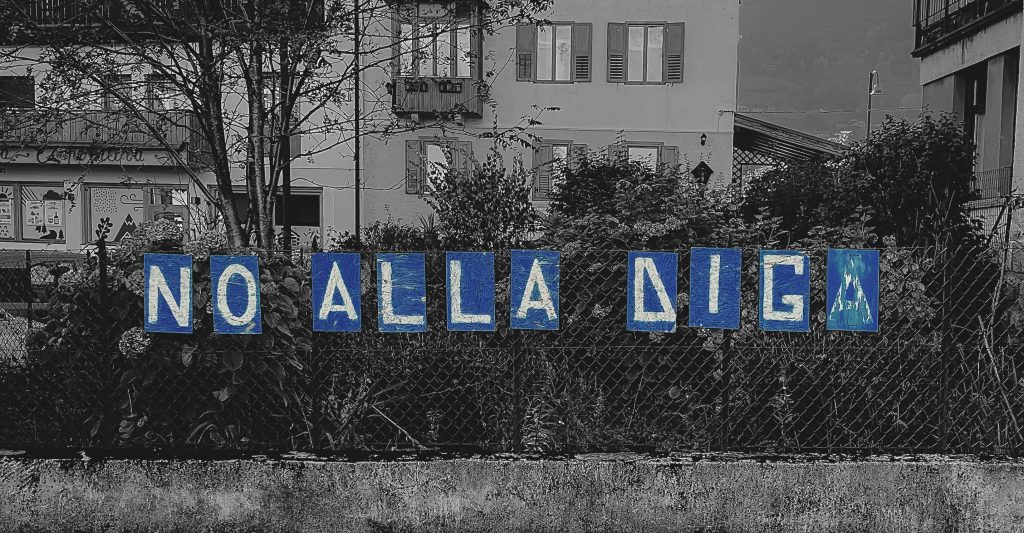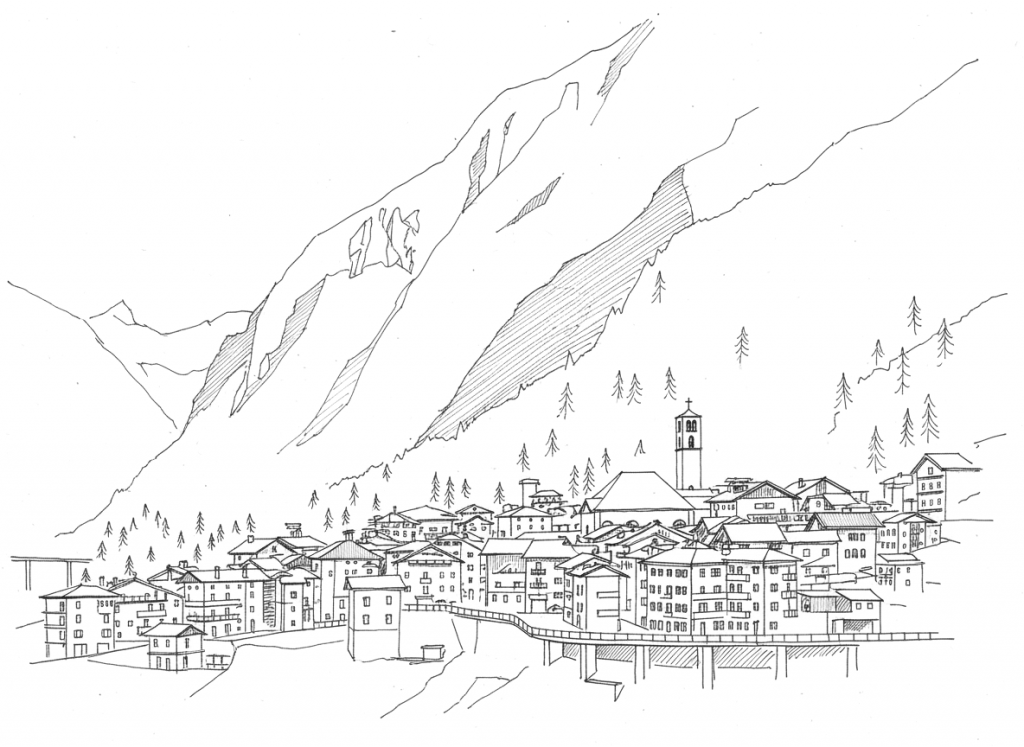
From Valle di Lei to Val Vanoi
Who decides the transformation of a valley?
Published in October 2025
In the final episode of the Territorial Elsewheres series “Chipping away at the monolith: reframing the Valle di Lei cross-border dam” we travel to Valle di Lei, a peculiar borderland between Italy and Switzerland. Here, a massive dam built in the late 1950s reveals long-standing tensions around local governance, energy production, and the appropriation of alpine spaces.
The testimonies collected in the episode challenge the conventional narrative that celebrates this infrastructure as a purely technical achievement. However, the dam emerges as “first and foremost a story of re-territorialization: a tangible redefinition, through water, energy, and labor, of what this place is and what it does”.
Sixty years on, a similar question has resurfaced in Val Vanoi, where currently there is an intense debate about the construction of a new dam that would cross Trentino and Veneto regions. An institutional standoff between Veneto and Trentino forces us to reconsider how major alpine infrastructure projects are decided and by whom.
#Monumentality #Infrastructure #AlpineValleys #TerritorialStudies


Vanoi: Re-territorialization Under Protest
Located in Trentino province, in Val Vanoi the Consorzio di Bonifica Brenta — a water management consortium based in Veneto — has designed a dam reaching 116-123 meters in height, with a reservoir capacity between 20 and 33 million cubic meters. Veneto’s regional president, Luca Zaia, listed it among six “urgent infrastructures” following the severe droughts of 2022-2023. Indeed the stated purpose is irrigation for the Veneto plains (Corriere del Veneto, 2023).
But the process has been polemical since the beginning. The dam is supposed to be built in Canal San Bovo. However, Bortolo Rattin mayor of the village explained: “We learned about the tender for the final design by chance. Nobody knew anything about it — not us, not Lamon, not the Province of Trento.” (Vez News, 2023). As a matter of fact, also the Autonomous Province of Trento discovered the project only from news reports and clearly it declared it illegitimate, with President Maurizio Fugatti expressing absolute opposition (Il Dolomiti, 2023). Opposition has been unanimous across the affected territory. All the municipalities of Primiero sent a formal objection in August 2024 (Il Dolomiti, 2025), backed like the Provinces of Trento and Belluno, the Italian Alpine Club (CAI), Legambiente, Mountain Wilderness, and a petition signed by 6,000 residents (L’indipendente, 2024).
The Vanoi dam has been proposed and rejected repeatedly: in the 1920s, 1950s (by the De Marchi Commission), and 1980s, each time blocked due to geological hazards (Il Manifesto, 2024; Corriere del Veneto, 2024). For decades, risk assessment processes prevented unsafe projects. Even though alternative solutions exist, they have never been taken into account apparently. Improving existing infrastructure, modernizing irrigation systems, managing aquifer recharge, and maintaining current dams (Il Fatto Quotidiano, 2024). These options have a different impact and wouldn’t require transforming another region’s valley.
However, public consultation began in July 2024, as required by law for dams exceeding 30 meters (L’Adige, 2024). The first meeting occurred on September 9 in Canal San Bovo (ANBI, 2024). But by that point, design contracts had been awarded, and funding was already allocated. Basically the consultation process was not binding.
Later, in February 2025, the Community of Primiero and its municipalities wrote to the Court of Auditors, arguing that further spending on executive design was pointless given the widespread territorial rejection (Primiero.tn.it, 2025). The consortium’s response was clear, It “intends to proceed regardless” (News in Quota, 2025).
Moreover there are also serious geological concerns. Val Cortella, where the reservoir would sit, is classified as maximum hydrogeological risk by the Province of Trento (Il Manifesto, 2024). Dating back to 1958, studies has identified significant sand cavities which means structural instability (Vez News, 2023). Also Mountain Wilderness stated in October 2024 that the valley presents documented serious geological and hydrogeological risks not appearing in the project (Mountain Wilderness, 2024). Thus, from this point of view, Provincial councilor Alessio Manica captured the essence of the institutional dynamic: “Veneto decides and Trentino suffers” (Il Dolomiti, 2023).


Patterns of Re-territorialization and hierarchies
Even though often from an unequal position, there is usually an ex-ante consultation or negotiation before the approval of a project, such as a dam, which frequently results in substantial economic compensation. Anyway, in the case of Val Vanoi, there has been no meaningful consultation, leading instead to an open institutional conflict (Provincia Autonoma di Trento, 2024). Val Vanoi case proposes re-territorialising valleys through processes that sideline or exclude the municipalities directly affected, plus it also shows the hierarchical spatial logic.
In fact, the Vanoi project seems to reproduce extractivist hierarchies. Primiero has already achieved 100% renewable energy supply through a local cooperative model, Primiero Energia (Primiero Energia, 2023). Indeed Primiero Energia is a publicly-owned local company where municipalities and the Primiero Community hold shares, ensuring local governance (Primiero Energia S.p.A., 2024). It achieves 100% renewable energy supply through existing hydroelectric plants and a biomass facility using local wood waste, serving around 1,000 buildings (Comuni Rinnovabili, 2014). Benefits and decision-making remain territorial. Primiero already demonstrates that local cooperative models can deliver renewable energy autonomy with territorial benefits.
“The Vanoi dam was proposed by the Consorzio di Bonifica Brenta primarily for irrigation purposes serving the Veneto plains, though the project also includes hydroelectric generation among its stated objectives” (Il Fatto Quotidiano, 2024; L’Adige, 2025; Consorzio Brenta, 2024). Then, apparently the dam would serve external agricultural needs under external control, potentially undermining a proven self-determination model.
This raises the question the Veneto consortium never addressed: if green energy transition is the goal, why not strengthen existing local cooperative models rather than impose top-down infrastructure that reproduces extractivist hierarchies?


An open question: who decides the transformation of a valley?
When municipalities lack real power, negotiation alone doesn’t ensure self-determination. Val Vanoi clearly exemplifies how institutional conflict simply replaces collaborative governance in the absence of binding participatory mechanisms. Behind infrastructural projects such as dams, lie processes of re-territorialization that reshape functions, economies, and power relations, in this case, across alpine territories.
Thus, the question remains unsolved: who has the legitimacy to decide whether an alpine valley should be re-territorialized?